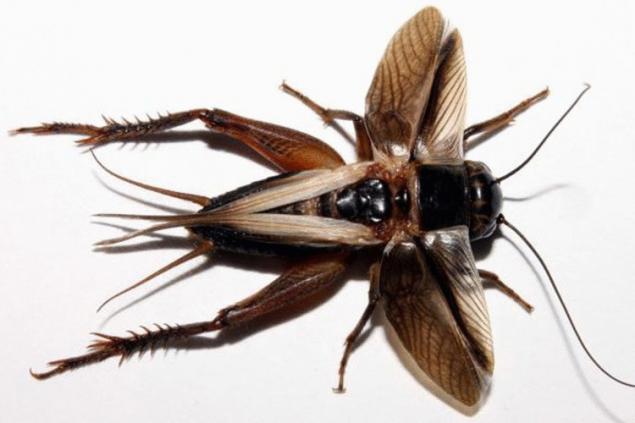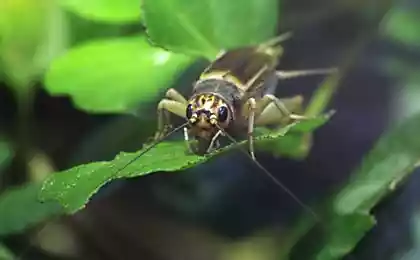454
To hide from the parasites, crickets losing my voice+video
Escaping from parasitic flies, crickets from the Islands of the Hawaiian archipelago using genetic tools.
Crickets, along with grasshoppers and cicadas are among the most famous of singing insects, but the mechanism of singing all these different singers arthropods. Speaking of crickets, their "tool" is wings: a serrated edge at the base of one of them rubs against the vein on the other, and the result is a clicking noise. About the same happens when we draw your finger across the teeth of a comb; the crickets the sound is further enhanced by the special anatomical adaptations and manner of execution.

On wings of song performed by the males by night the sound of cricket is a signal of the potential partner and at the same time a warning to competitors. However, males сверчковTeleogryllus Oceana Hawaii was another listener, and that is highly undesirable parasitic, egemenoglu ochracea. Generally iemochi, or tahini, spetsializiruyutsya parasitism, laying eggs in other insects .O. ochracea selected for breeding crickets: its larva penetrates into the body of the host and develops 7-10 days, gradually killing the cricket.
In Hawaii both species was found in the late twentieth century: T. oceanicus crickets came from Oceania, eremua from North America. When faced with a parasitic threat, crickets decided to shut up. Of course, it was not a willful decision insects, and evolutionary: amongst the crickets, the benefit received males with mutations that changed the structure of the wings, making play impossible. With wings disappeared projections and irregularities, which have generated the sound, but the ability to fly is not affected. In 2006 Marlene ZUK (Marlene Zuk) University of California, riverside found that 95% of samsoft. Oceana the island of Kauai "lost voice." For such adjustment took only 20 generations of insects; just little time, if judged by ordinary evolutionary standards.
Two years later, the researchers noticed that the crickets began to break off and on the island of Oahu, which is 101 kilometers from Kauai; now there silent, already half of the crickets. The two populations manifested the same symptom, researchers are strongly interested in.
At first, they suggested that the mutant crickets just moved from one island to another with the unwitting help of man, for example, on aircraft or ships. But then, when the silent crickets from both Islands was compared, it was found that they are very different from each other: for example, in comparison with males from the island of Kauai crickets from the island of Oahu lost significantly less anatomical structures necessary for chirping.
Anatomical comparisons, the researchers reinforced the comparison of the genetic. DNA analysis showed that changes in genes, which led to a change in the wings differed from crickets from different Islands. That is, the same problem was solved in various ways. Your results Marlene ZUK and her colleagues have published вCurrent Biology. Of course, the question arises as males compensated for these mutations in breeding behavior, because with the chirping of the males called females and now search for partners for them, I suppose, has become much more difficult. In fact, however, in this study, the important thing is not crickets – it's hardly the only case where biologists can observe convergent evolution in real time. About this type of evolution is usually said in the case of different species that evolved similar characteristics under the influence of similar environmental conditions (as, for example, the hawk and the Hummingbird, in a similar way hangs over the flower). But we can talk about the convergence of different populations of the same species, as in the case with the crickets. Evolution the General view is that the process is extremely long, and in real time we can watch it only on bacteria, yeast and other microorganisms. And often evolutionary descriptions have the character of explanations of what already happened.
But, as you can see, sometimes the evolution of the "largest organisms" it is possible to see within a very short time, as happened with the convergence of crickets. This allows us to study the very beginning of the evolutionary process, that it is almost impossible to do, watching the animals in their natural environment.
Source: nkj.ru
Crickets, along with grasshoppers and cicadas are among the most famous of singing insects, but the mechanism of singing all these different singers arthropods. Speaking of crickets, their "tool" is wings: a serrated edge at the base of one of them rubs against the vein on the other, and the result is a clicking noise. About the same happens when we draw your finger across the teeth of a comb; the crickets the sound is further enhanced by the special anatomical adaptations and manner of execution.

On wings of song performed by the males by night the sound of cricket is a signal of the potential partner and at the same time a warning to competitors. However, males сверчковTeleogryllus Oceana Hawaii was another listener, and that is highly undesirable parasitic, egemenoglu ochracea. Generally iemochi, or tahini, spetsializiruyutsya parasitism, laying eggs in other insects .O. ochracea selected for breeding crickets: its larva penetrates into the body of the host and develops 7-10 days, gradually killing the cricket.
In Hawaii both species was found in the late twentieth century: T. oceanicus crickets came from Oceania, eremua from North America. When faced with a parasitic threat, crickets decided to shut up. Of course, it was not a willful decision insects, and evolutionary: amongst the crickets, the benefit received males with mutations that changed the structure of the wings, making play impossible. With wings disappeared projections and irregularities, which have generated the sound, but the ability to fly is not affected. In 2006 Marlene ZUK (Marlene Zuk) University of California, riverside found that 95% of samsoft. Oceana the island of Kauai "lost voice." For such adjustment took only 20 generations of insects; just little time, if judged by ordinary evolutionary standards.
Two years later, the researchers noticed that the crickets began to break off and on the island of Oahu, which is 101 kilometers from Kauai; now there silent, already half of the crickets. The two populations manifested the same symptom, researchers are strongly interested in.
At first, they suggested that the mutant crickets just moved from one island to another with the unwitting help of man, for example, on aircraft or ships. But then, when the silent crickets from both Islands was compared, it was found that they are very different from each other: for example, in comparison with males from the island of Kauai crickets from the island of Oahu lost significantly less anatomical structures necessary for chirping.
Anatomical comparisons, the researchers reinforced the comparison of the genetic. DNA analysis showed that changes in genes, which led to a change in the wings differed from crickets from different Islands. That is, the same problem was solved in various ways. Your results Marlene ZUK and her colleagues have published вCurrent Biology. Of course, the question arises as males compensated for these mutations in breeding behavior, because with the chirping of the males called females and now search for partners for them, I suppose, has become much more difficult. In fact, however, in this study, the important thing is not crickets – it's hardly the only case where biologists can observe convergent evolution in real time. About this type of evolution is usually said in the case of different species that evolved similar characteristics under the influence of similar environmental conditions (as, for example, the hawk and the Hummingbird, in a similar way hangs over the flower). But we can talk about the convergence of different populations of the same species, as in the case with the crickets. Evolution the General view is that the process is extremely long, and in real time we can watch it only on bacteria, yeast and other microorganisms. And often evolutionary descriptions have the character of explanations of what already happened.
But, as you can see, sometimes the evolution of the "largest organisms" it is possible to see within a very short time, as happened with the convergence of crickets. This allows us to study the very beginning of the evolutionary process, that it is almost impossible to do, watching the animals in their natural environment.
Source: nkj.ru
“Smart” buoy will warn about the approach of sharks
Build a grill out of brick with their hands + video























